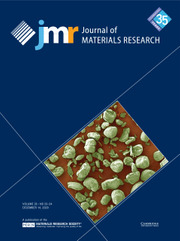Crossref Citations
This article has been cited by the following publications. This list is generated based on data provided by
Crossref.
Nam, Do-Hwan
Lim, Sung-Jin
Kim, Min-Joong
and
Kwon, Hyuk-Sang
2013.
Facile synthesis of SnO2-polypyrrole hybrid nanowires by cathodic electrodeposition and their application to Li-ion battery anodes.
RSC Advances,
Vol. 3,
Issue. 36,
p.
16102.
Das, Dhaneswar
Nath, Bikash C.
Phukon, Pinkee
Saikia, Bhaskar J.
Kamrupi, Isha R.
and
Dolui, Swapan K.
2013.
Nickel oxide/polypyrrole/silver nanocomposites with core/shell/shell structure: Synthesis, characterization and their electrochemical behaviour with antimicrobial activities.
Materials Chemistry and Physics,
Vol. 142,
Issue. 1,
p.
61.
Ding, Zhaojun
Yao, Bin
Feng, Jinkui
and
Zhang, Jianxin
2013.
Enhanced rate performance and cycling stability of a CoCO3–polypyrrole composite for lithium ion battery anodes.
Journal of Materials Chemistry A,
Vol. 1,
Issue. 37,
p.
11200.
Seng, Kuok Hau
Li, Li
Chen, Da-Peng
Chen, Zhi Xin
Wang, Xiao-Lin
Liu, Hua Kun
and
Guo, Zai Ping
2013.
The effects of FEC (fluoroethylene carbonate) electrolyte additive on the lithium storage properties of NiO (nickel oxide) nanocuboids.
Energy,
Vol. 58,
Issue. ,
p.
707.
Banu, Alexandra
Marcu, Maria
Alexandrescu, Elvira
and
Anghel, Elena Maria
2014.
Electrochemical deposition and characterization of polyppyrrole coatings doped with nickel cobalt oxide for environmental applications.
Journal of Solid State Electrochemistry,
Vol. 18,
Issue. 10,
p.
2661.
Holze, R.
and
Wu, Y.P.
2014.
Intrinsically conducting polymers in electrochemical energy technology: Trends and progress.
Electrochimica Acta,
Vol. 122,
Issue. ,
p.
93.
Xie, Kongwei
Yin, Jinwei
Shi, Huimin
Zhu, Qingyun
Wu, Ping
Tang, Yawen
Zhou, Yiming
and
Lu, Tianhong
2015.
Designed synthesis of NiO@polypyrrole hollow spheres for long-life lithium storage.
Ionics,
Vol. 21,
Issue. 2,
p.
359.
Khutia, Moumita
and
Joshi, Girish M.
2015.
Dielectric relaxation of PVC/PMMA/NiO blends as a function of DC bias.
Journal of Materials Science: Materials in Electronics,
Vol. 26,
Issue. 7,
p.
5475.
Ghosh, Sutapa
and
Chilaka, Naresh
2015.
Polymer Nanocomposites Based on Inorganic and Organic Nanomaterials.
p.
483.
Shilpa, Shilpa
Basavaraja, Basavanakote M.
Majumder, Subhasish B.
and
Sharma, Ashutosh
2015.
Electrospun hollow glassy carbon–reduced graphene oxide nanofibers with encapsulated ZnO nanoparticles: a free standing anode for Li-ion batteries.
Journal of Materials Chemistry A,
Vol. 3,
Issue. 10,
p.
5344.
Sehgal, Preeti
and
Narula, Anudeep Kumar
2015.
Structural, morphological, optical, and electrical transport studies of poly(3-methoxythiophene)/NiO hybrid nanocomposites.
Colloid and Polymer Science,
Vol. 293,
Issue. 9,
p.
2689.
Sengodu, Prakash
and
Deshmukh, Abhay D.
2015.
Conducting polymers and their inorganic composites for advanced Li-ion batteries: a review.
RSC Advances,
Vol. 5,
Issue. 52,
p.
42109.
Tkach, Volodymyr V.
Ojani, Reza
Zarei, Ebrahim
Nechyporuk, Vasyl´ V.
Yagodynets´, Petró I.
and
Oliveira, Sílvio C. de
2015.
Descripción matemática del desempeño electroanalítico de nanopartículas de derivados de níquel en la determinación cualitativa y cuantitativa de metanol.
Revista Colombiana de Ciencias Químico-Farmacéuticas,
Vol. 44,
Issue. 1,
p.
5.
Khutia, Moumita
Joshi, Girish M.
and
Pandey, Mayank
2015.
Improved Dielectric Constant of Modified Polymer Blend by Nickel Oxide Nanoparticles.
Materials Today: Proceedings,
Vol. 2,
Issue. 9,
p.
4620.
Zhao, Hu
Liu, Lei
Hu, Zhongbo
Sun, Limei
Han, Songbai
Liu, Yuntao
Chen, Dongfeng
and
Liu, Xiangfeng
2016.
Neutron diffraction analysis and electrochemical performance of spinel Ni(Mn2−Co )O4 as anode materials for lithium ion battery.
Materials Research Bulletin,
Vol. 77,
Issue. ,
p.
265.
Arcila-Velez, Margarita R.
Emmett, Robert K.
Karakaya, Mehmet
Podila, Ramakrishna
Díaz-Orellana, Kryssia P.
Rao, Apparao M.
and
Roberts, Mark E.
2016.
A facile and scalable approach to fabricating free-standing polymer—Carbon nanotube composite electrodes.
Synthetic Metals,
Vol. 215,
Issue. ,
p.
35.
Sengodu, Prakash
2017.
Polymer-Engineered Nanostructures for Advanced Energy Applications.
p.
365.
Shanthala, V.S.
Shobha Devi, S.N.
and
Murugendrappa, M.V.
2017.
Synthesis, characterization and DC conductivity studies of polypyrrole/copper zinc iron oxide nanocomposites.
Journal of Asian Ceramic Societies,
Vol. 5,
Issue. 3,
p.
227.
Feng, Lili
Zhang, Yinyin
Wang, Rui
Zhang, Yanli
Bai, Wei
Ji, Siping
Xuan, Zhewen
Yang, Jianhua
Zheng, Ziguang
and
Guan, Hongjin
2017.
Preparation of PPy-Coated MnO2 Hybrid Micromaterials and Their Improved Cyclic Performance as Anode for Lithium-Ion Batteries.
Nanoscale Research Letters,
Vol. 12,
Issue. 1,
Papiya, Farhan
Pattanayak, Prasanta
Kumar, Piyush
Kumar, Vikash
and
Kundu, Patit Paban
2018.
Development of highly efficient bimetallic nanocomposite cathode catalyst, composed of Ni:Co supported sulfonated polyaniline for application in microbial fuel cells.
Electrochimica Acta,
Vol. 282,
Issue. ,
p.
931.





